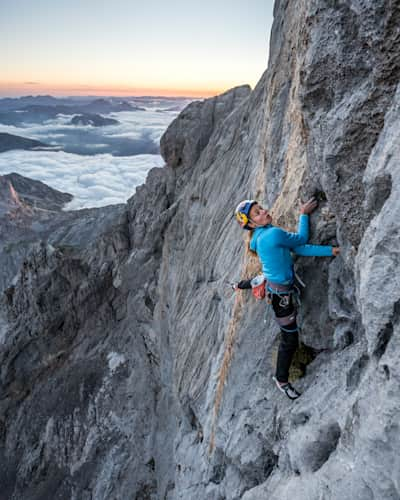
Climbing
10 mental training techniques for climbing
Mental preparation like breathwork and visualization can help you accomplish goals faster with a clearer mind.
“We were living the dream. People saw the magazine covers and the videos. But they didn’t know what was underneath,” says climber Beth Rodden in Season 8, Episode 7 of "Reel Rock."
Beth goes on to detail her intense struggles with self-destructive behavior, which has plagued her throughout her wildly successful climbing career—an unfortunate problem many climbers (and people in general) can relate to.
Cultivating a resilient mindset isn’t just a way to improve as a climber. It’s also a life skill. Mental preparation like breathwork and visualization can help you accomplish goals faster with a clearer mind. Techniques like fear harnessing can also help you live a more fulfilling life with less self-sabotage and internal pain.
10 Mental Training Techniques for Climbing
Here are 10 mental training techniques for climbing to develop toughness and promote inner clarity so you can be at your best.
01
Practice Controlled Breathing
You can try a simple breathing technique for climbing called “box breathing.” Breathe in for four seconds, hold for four seconds, and exhale for four seconds. Repeat three times or until you feel calm.
Your breath and physiology are intimately connected. When you slow your breathing, you slow your heart rate. You also reduce stress hormones like cortisol which spike when you get nervous, making it difficult to think clearly.
02
Keep Your Mind Occupied During Climb
The breath is a great anchor to focus on when you climb the route because it happens automatically and keeps you locked into the present moment. Focus on your breath wherever you feel it the most—inside the nostril, in your chest, in your lower abdomen, where your stomach expands and contracts. When distractions come (and they will), set your focus back on the area you chose, and practice that over and over, starting at five minutes and working your way up to 20 or more.
A busy mind doesn’t have time to panic about the fear of falling or generate critical self-talk. It’s especially useful when training on routes at or slightly beyond your current abilities.
03
Pay Attention to Your Own Body Language
Make an effort to pay attention to your body language and ask yourself what it’s saying. One easy technique is to do a slouch check several times per day. If you’re slouching, pull your shoulders back, sit or stand tall, and display a “proud” chest.
Angie Scarth-Johnson in the Blue Mountains, New South Wales, Australia
© Kamil Sustiak / Red Bull Content Pool
Nerves and anxiety can and do have physical consequences, especially when you don’t control them and they linger. Even when you aren’t climbing, this is a great way to project self-esteem and train your mind to stay positive.
04
Identify Fears
Naming what you’re afraid of is the best first step to alleviate the fear. Coming up with a list of fears on a jagged edge might be a little overwhelming—so consider keeping a climbing journal to reflect on how you feel after a tough climb. Write about what you’re nervous about in the future and the worst possible outcomes.
By identifying a fear on paper or out loud, you take it out of your body and give it less power. You also look into the face of the thing that bothers you most.
05
Leave Your Comfort Zone
Be intentional about your climbing training. Make sure at least once every few weeks, you’re stretching beyond what’s easy or known. Confidence is born through repetition. The more you focus on improving your skill, the more refined and strong your mindset will become.
A caveat, though: constantly grinding yourself down isn’t the answer. Difficult training brings fatigue and other negatives that you must recover from. Finding a balance is key for sustainable climbing training, which emphasizes taking care of yourself and the natural environment(s) you climb in.
06
Reduce Self-Induced Pressure
Write down or just think critically about what brought you here. Discover your core “why.” Do a five-minute free write about why you love climbing and what keeps you coming back. Then try to craft those words into a single sentence.
An example: I climb because it helps me pursue the best version of myself.
Distractions are very easy to find in the modern world. Social media and even our peers can take us away from our goal of simply being present or improving our skills. As your climbing skills improve, you might find yourself getting away from what got you into climbing in the first place. All that pressure becomes just another distraction.
To get back on track, you need to reconnect with the source.
07
Always Focus
Focus is a skill in and of itself. Where your focus goes, energy flows. The breath exercise discussed earlier is a great place to start if you are new to focus training. Or you can just make a point of seeing where your focus is when you climb. Like watching the breath, practice bringing your attention back to the present moment every time it scatters. The more you can stay in the present moment, the less opportunity fear or negativity has to creep in.
Don McGrath’s book "Vertical Mind" focuses largely on this, along with other mental techniques for optimizing your climbing.
08
Visualize Movements
Picture your next successful climb. Walk yourself through each handhold and foot placement. What will it feel like? What will you say to yourself? Go through each moment until you arrive at a desirable outcome. Then do it again.
As with other sports, like rugby, where captain Siya Kolisi says visualization is key to his success, mental imagery is one of the most powerful climbing mental training techniques you can use to improve decision-making and bolster confidence. These mental repetitions can help you perform and get more “reps” in when you can’t train.
09
Climb With Positive People
The people we surround ourselves with can absolutely have an impact on our mental health and performance. It may be you against you on the wall, but the joy we feel climbing often comes down to who we are with. Make it a priority to climb with people who bring you up, not down. Your mental strength and physical strength will improve as a result.
10
Climb With Confidence
Trust in the work you’ve put in. Remember, doing hard things makes it easier to do hard things. So remember where you come from and use that knowledge to grow!
Confidence isn’t born from positive thinking; it’s born from repetition and a clear state of mind that you cultivate from hard work. Take a moment to think about your training schedule or write it down. Ask honestly: Is there enough to challenge you there? Is your program helping you grow? If not, come up with a new plan designed to test yourself.
When you do the work, you never have to worry about things like imposter syndrome again.
Conclusion
The mind is a powerful tool we can use to achieve our goals—but it can also be a hindrance if we get stuck with our fears or mired in our negative self-talk. Implementing breathwork, practicing mental imagery, and starting a climbing journal are ways to improve mental toughness and clarity.
As big wave surfer, Mark Matthews puts it, “everyone is scared.” But being apprehensive doesn’t mean you shouldn’t be doing it.
You don’t have to go climbing in the Himalayas to “qualify” for mental toughness training. Start wherever you’re at and see how these techniques help you grow as a climber and as a person.






